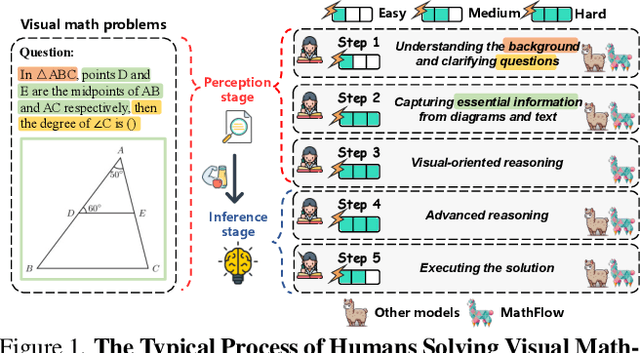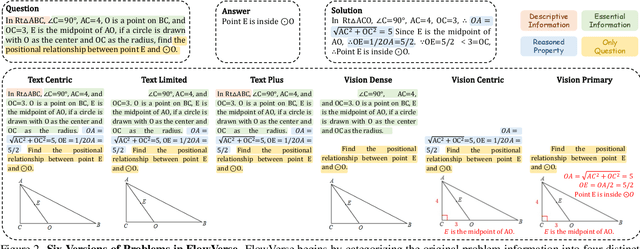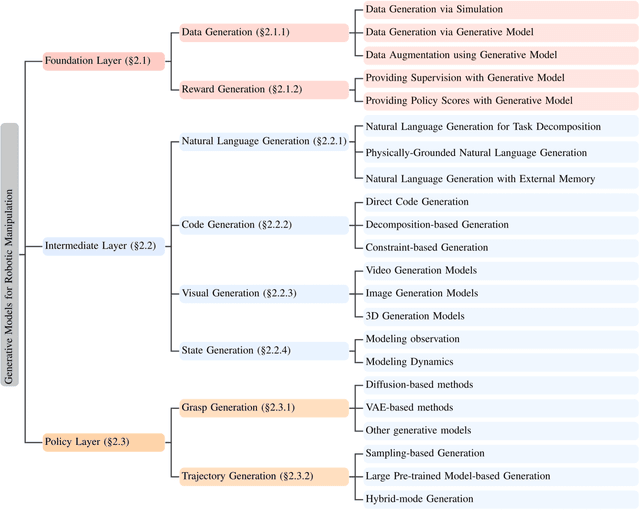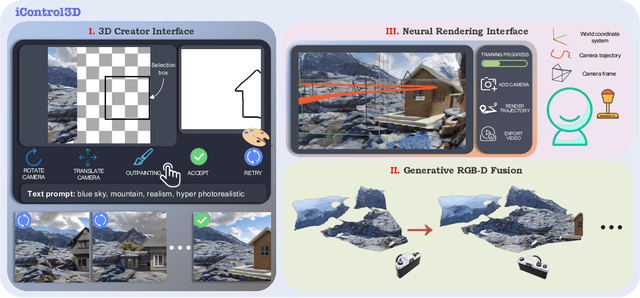Jun Cen
RynnVLA-001: Using Human Demonstrations to Improve Robot Manipulation
Sep 18, 2025Abstract:This paper presents RynnVLA-001, a vision-language-action(VLA) model built upon large-scale video generative pretraining from human demonstrations. We propose a novel two-stage pretraining methodology. The first stage, Ego-Centric Video Generative Pretraining, trains an Image-to-Video model on 12M ego-centric manipulation videos to predict future frames conditioned on an initial frame and a language instruction. The second stage, Human-Centric Trajectory-Aware Modeling, extends this by jointly predicting future keypoint trajectories, thereby effectively bridging visual frame prediction with action prediction. Furthermore, to enhance action representation, we propose ActionVAE, a variational autoencoder that compresses sequences of actions into compact latent embeddings, reducing the complexity of the VLA output space. When finetuned on the same downstream robotics datasets, RynnVLA-001 achieves superior performance over state-of-the-art baselines, demonstrating that the proposed pretraining strategy provides a more effective initialization for VLA models.
Towards Affordance-Aware Robotic Dexterous Grasping with Human-like Priors
Aug 12, 2025Abstract:A dexterous hand capable of generalizable grasping objects is fundamental for the development of general-purpose embodied AI. However, previous methods focus narrowly on low-level grasp stability metrics, neglecting affordance-aware positioning and human-like poses which are crucial for downstream manipulation. To address these limitations, we propose AffordDex, a novel framework with two-stage training that learns a universal grasping policy with an inherent understanding of both motion priors and object affordances. In the first stage, a trajectory imitator is pre-trained on a large corpus of human hand motions to instill a strong prior for natural movement. In the second stage, a residual module is trained to adapt these general human-like motions to specific object instances. This refinement is critically guided by two components: our Negative Affordance-aware Segmentation (NAA) module, which identifies functionally inappropriate contact regions, and a privileged teacher-student distillation process that ensures the final vision-based policy is highly successful. Extensive experiments demonstrate that AffordDex not only achieves universal dexterous grasping but also remains remarkably human-like in posture and functionally appropriate in contact location. As a result, AffordDex significantly outperforms state-of-the-art baselines across seen objects, unseen instances, and even entirely novel categories.
WorldVLA: Towards Autoregressive Action World Model
Jun 26, 2025Abstract:We present WorldVLA, an autoregressive action world model that unifies action and image understanding and generation. Our WorldVLA intergrates Vision-Language-Action (VLA) model and world model in one single framework. The world model predicts future images by leveraging both action and image understanding, with the purpose of learning the underlying physics of the environment to improve action generation. Meanwhile, the action model generates the subsequent actions based on image observations, aiding in visual understanding and in turn helps visual generation of the world model. We demonstrate that WorldVLA outperforms standalone action and world models, highlighting the mutual enhancement between the world model and the action model. In addition, we find that the performance of the action model deteriorates when generating sequences of actions in an autoregressive manner. This phenomenon can be attributed to the model's limited generalization capability for action prediction, leading to the propagation of errors from earlier actions to subsequent ones. To address this issue, we propose an attention mask strategy that selectively masks prior actions during the generation of the current action, which shows significant performance improvement in the action chunk generation task.
MathFlow: Enhancing the Perceptual Flow of MLLMs for Visual Mathematical Problems
Mar 19, 2025



Abstract:Despite impressive performance across diverse tasks, Multimodal Large Language Models (MLLMs) have yet to fully demonstrate their potential in visual mathematical problem-solving, particularly in accurately perceiving and interpreting diagrams. Inspired by typical processes of humans, we hypothesize that the perception capabilities to extract meaningful information from diagrams is crucial, as it directly impacts subsequent inference processes. To validate this hypothesis, we developed FlowVerse, a comprehensive benchmark that categorizes all information used during problem-solving into four components, which are then combined into six problem versions for evaluation. Our preliminary results on FlowVerse reveal that existing MLLMs exhibit substantial limitations when extracting essential information and reasoned property from diagrams and performing complex reasoning based on these visual inputs. In response, we introduce MathFlow, a modular problem-solving pipeline that decouples perception and inference into distinct stages, thereby optimizing each independently. Given the perceptual limitations observed in current MLLMs, we trained MathFlow-P-7B as a dedicated perception model. Experimental results indicate that MathFlow-P-7B yields substantial performance gains when integrated with various closed-source and open-source inference models. This demonstrates the effectiveness of the MathFlow pipeline and its compatibility to diverse inference frameworks. The FlowVerse benchmark and code are available at https://github.com/MathFlow-zju/MathFlow.
Generative Artificial Intelligence in Robotic Manipulation: A Survey
Mar 05, 2025



Abstract:This survey provides a comprehensive review on recent advancements of generative learning models in robotic manipulation, addressing key challenges in the field. Robotic manipulation faces critical bottlenecks, including significant challenges in insufficient data and inefficient data acquisition, long-horizon and complex task planning, and the multi-modality reasoning ability for robust policy learning performance across diverse environments. To tackle these challenges, this survey introduces several generative model paradigms, including Generative Adversarial Networks (GANs), Variational Autoencoders (VAEs), diffusion models, probabilistic flow models, and autoregressive models, highlighting their strengths and limitations. The applications of these models are categorized into three hierarchical layers: the Foundation Layer, focusing on data generation and reward generation; the Intermediate Layer, covering language, code, visual, and state generation; and the Policy Layer, emphasizing grasp generation and trajectory generation. Each layer is explored in detail, along with notable works that have advanced the state of the art. Finally, the survey outlines future research directions and challenges, emphasizing the need for improved efficiency in data utilization, better handling of long-horizon tasks, and enhanced generalization across diverse robotic scenarios. All the related resources, including research papers, open-source data, and projects, are collected for the community in https://github.com/GAI4Manipulation/AwesomeGAIManipulation
LargeAD: Large-Scale Cross-Sensor Data Pretraining for Autonomous Driving
Jan 07, 2025Abstract:Recent advancements in vision foundation models (VFMs) have revolutionized visual perception in 2D, yet their potential for 3D scene understanding, particularly in autonomous driving applications, remains underexplored. In this paper, we introduce LargeAD, a versatile and scalable framework designed for large-scale 3D pretraining across diverse real-world driving datasets. Our framework leverages VFMs to extract semantically rich superpixels from 2D images, which are aligned with LiDAR point clouds to generate high-quality contrastive samples. This alignment facilitates cross-modal representation learning, enhancing the semantic consistency between 2D and 3D data. We introduce several key innovations: i) VFM-driven superpixel generation for detailed semantic representation, ii) a VFM-assisted contrastive learning strategy to align multimodal features, iii) superpoint temporal consistency to maintain stable representations across time, and iv) multi-source data pretraining to generalize across various LiDAR configurations. Our approach delivers significant performance improvements over state-of-the-art methods in both linear probing and fine-tuning tasks for both LiDAR-based segmentation and object detection. Extensive experiments on eleven large-scale multi-modal datasets highlight our superior performance, demonstrating the adaptability, efficiency, and robustness in real-world autonomous driving scenarios.
Continual Learning for Segment Anything Model Adaptation
Dec 09, 2024Abstract:Although the current different types of SAM adaptation methods have achieved promising performance for various downstream tasks, such as prompt-based ones and adapter-based ones, most of them belong to the one-step adaptation paradigm. In real-world scenarios, we are generally confronted with the dynamic scenario where the data comes in a streaming manner. Driven by the practical need, in this paper, we first propose a novel Continual SAM adaptation (CoSAM) benchmark with 8 different task domains and carefully analyze the limitations of the existing SAM one-step adaptation methods in the continual segmentation scenario. Then we propose a novel simple-yet-effective Mixture of Domain Adapters (MoDA) algorithm which utilizes the Global Feature Tokens (GFT) and Global Assistant Tokens (GAT) modules to help the SAM encoder extract well-separated features for different task domains, and then provide the accurate task-specific information for continual learning. Extensive experiments demonstrate that our proposed MoDA obviously surpasses the existing classic continual learning methods, as well as prompt-based and adapter-based approaches for continual segmentation. Moreover, after sequential learning on the CoSAM benchmark with diverse data distributions, our MoDA maintains highly competitive results in the natural image domain, approaching the zero-shot performance of the original SAM, demonstrating its superior capability in knowledge preservation. Notably, the proposed MoDA can be seamlessly integrated into various one-step adaptation methods of SAM, which can consistently bring obvious performance gains. Code is available at \url{https://github.com/yangjl1215/CoSAM}
SimCMF: A Simple Cross-modal Fine-tuning Strategy from Vision Foundation Models to Any Imaging Modality
Nov 27, 2024



Abstract:Foundation models like ChatGPT and Sora that are trained on a huge scale of data have made a revolutionary social impact. However, it is extremely challenging for sensors in many different fields to collect similar scales of natural images to train strong foundation models. To this end, this work presents a simple and effective framework, SimCMF, to study an important problem: cross-modal fine-tuning from vision foundation models trained on natural RGB images to other imaging modalities of different physical properties (e.g., polarization). In SimCMF, we conduct a thorough analysis of different basic components from the most naive design and ultimately propose a novel cross-modal alignment module to address the modality misalignment problem. We apply SimCMF to a representative vision foundation model Segment Anything Model (SAM) to support any evaluated new imaging modality. Given the absence of relevant benchmarks, we construct a benchmark for performance evaluation. Our experiments confirm the intriguing potential of transferring vision foundation models in enhancing other sensors' performance. SimCMF can improve the segmentation performance (mIoU) from 22.15% to 53.88% on average for evaluated modalities and consistently outperforms other baselines. The code is available at https://github.com/mt-cly/SimCMF
SimMAT: Exploring Transferability from Vision Foundation Models to Any Image Modality
Sep 12, 2024



Abstract:Foundation models like ChatGPT and Sora that are trained on a huge scale of data have made a revolutionary social impact. However, it is extremely challenging for sensors in many different fields to collect similar scales of natural images to train strong foundation models. To this end, this work presents a simple and effective framework SimMAT to study an open problem: the transferability from vision foundation models trained on natural RGB images to other image modalities of different physical properties (e.g., polarization). SimMAT consists of a modality-agnostic transfer layer (MAT) and a pretrained foundation model. We apply SimMAT to a representative vision foundation model Segment Anything Model (SAM) to support any evaluated new image modality. Given the absence of relevant benchmarks, we construct a new benchmark to evaluate the transfer learning performance. Our experiments confirm the intriguing potential of transferring vision foundation models in enhancing other sensors' performance. Specifically, SimMAT can improve the segmentation performance (mIoU) from 22.15% to 53.88% on average for evaluated modalities and consistently outperforms other baselines. We hope that SimMAT can raise awareness of cross-modal transfer learning and benefit various fields for better results with vision foundation models.
iControl3D: An Interactive System for Controllable 3D Scene Generation
Aug 03, 2024



Abstract:3D content creation has long been a complex and time-consuming process, often requiring specialized skills and resources. While recent advancements have allowed for text-guided 3D object and scene generation, they still fall short of providing sufficient control over the generation process, leading to a gap between the user's creative vision and the generated results. In this paper, we present iControl3D, a novel interactive system that empowers users to generate and render customizable 3D scenes with precise control. To this end, a 3D creator interface has been developed to provide users with fine-grained control over the creation process. Technically, we leverage 3D meshes as an intermediary proxy to iteratively merge individual 2D diffusion-generated images into a cohesive and unified 3D scene representation. To ensure seamless integration of 3D meshes, we propose to perform boundary-aware depth alignment before fusing the newly generated mesh with the existing one in 3D space. Additionally, to effectively manage depth discrepancies between remote content and foreground, we propose to model remote content separately with an environment map instead of 3D meshes. Finally, our neural rendering interface enables users to build a radiance field of their scene online and navigate the entire scene. Extensive experiments have been conducted to demonstrate the effectiveness of our system. The code will be made available at https://github.com/xingyi-li/iControl3D.
 Add to Chrome
Add to Chrome Add to Firefox
Add to Firefox Add to Edge
Add to Edge